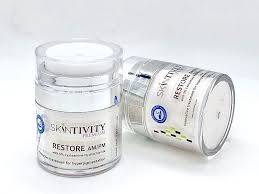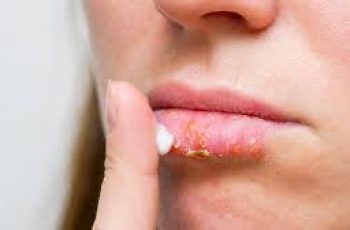Cysteamine in Skin Care
Cysteamine is a new cosmeceutical ingredient used in skin lightening products.
It is relatively new ingredient used to lighten dark spots because for years the compound was considered too unstable to last on shelves before turning rancid.
New processes have been developed which prevent degradation and enable this ingredient’s use in modern skin care. (4,5)
Cysteamine is great for treating dark spots and preventing sun damage, but it isn’t perfect for every skin type. It is a tyrosinase inhibitor.
Cysteamine is the simplest compound in the aminothiol Family. It is naturally present in the body.
Aminothiols are used as protective ingredients against radiation.
It can be found in many mammal tissues, but is found in highest natural concentrations in mammal milk.(3)
To make sure cysteamine is right for your skin, shop by your Baumann Skin Type!
Benefits
The primary benefit of cysteamine is that it is much safer as a skin lightener than hydroquinone with comparable efficacy.
Other skin lighteners such as kojic acid are a little less irritating to skin, but also less effective.
Because it also absorbs radiation, this ingredient may help prevent sun burns and sun damage when used in combination with sunscreen.
Which skin types should use Cysteamine?
Skin types that are not sensitive to inflammation are good candidates for this potent skin lightening ingredient. That being said, not all skin types require a lightening ingredient in their regimen. The skin types that we think this ingredient is best for are:
Skin type 9: ORPT
Skin type 11: ORPW
Skin type 13: DRPT
Skin type 15: DRPW
Basically, if your skin is resistant to inflammation and also has irregular pigmentation, cysteamine is a great choice for you.
Which skin types should avoid cysteamine?
In general, the skin types that should avoid cysteamine are those prone to inflammation. Inflammation can lead to subsequent conditions like post inflammatory hyperpigmentation, redness, or stinging in general.
If your skin type has sensitivity and inflammation as one of their barriers to skin health, you should avoid this ingredient. If you use an anti-inflammatory alongside cysteamine, however, there is less risk of inflammation even for sensitive types.
In particular, we advise the following skin types to consider skin lighteners with less abrasive sensations if they do not also have anti-inflammatories:
Skin type 1: DSPT
Skin type 2: DSNT
Skin type 3: DSPW
Skin type 4: DSNW
Skin type 5: OSPT
Skin type 6: OSNT
Skin type 7: OSPW
Skin type 8: OSNW
This is to say that sensitive skin types, whether they are pigmented or not, are not always the best candidates for cysteamine in their custom regimens.
Side effects
There are a few common short term side effects from using cysteamine products, but none of them are true threats to your skin health.
It is common to experience mild redness and stinging for about 30 minutes; this is completely normal and safe during the first few days of treatment.
If continued use of cysteamine products is irritating your skin, consider layering an anti-inflammatory product on top.
No studies surrounding usage while pregnant or breast-feeding have been done, so it is recommended to avoid products containing this ingredient under those conditions until research is produced.
If you are pregnant, there are multiple effective and proven safe treatments for hyperpigmentation conditions like melasma.
This ingredient is also worth avoiding if you have vitiligo, as the treatments for vitiligo involve producing more melanin, not inhibiting pigment production with tyrosinase inhibitors.
Is cysteamine safe?
It is considered completely safe for use in skin care as long as it is used properly within your custom skin care regimen!
The EWG rating for cysteamine is “1” which means there are no commonly associated risks or concerns with this ingredient.
Many studies on this ingredient have found it to be a safe alternative to the controversial hydroquinone, which itself has a few associated risks.(7)
As a naturally occurring compound in the human body, cysteamine is entirely non-toxic and safe to use depending on your skin concerns.
cysteamine for hyperpigmentation
For hyperpigmentation
Cysteamine is an effective skin lightening ingredient which is more easily absorbed by the human body than competing skin lighteners.It is a potent tyrosinase inhibitor.
It becomes increasingly common as a skin lightening ingredient every year as more research comes out to support its efficacy.(5)
It is considered the most effective natural compound for the treatment of melasma.
Unlike other skin lighteners like hydroquinone, this ingredient is free of many common concerns having to do with mutagenicity or carcinogenicity.
In fact, it has demonstrated anti-carcinogenic and anti-mutagenic properties. (3)
Despite its effectiveness, some people find the irritating initial feeling of cysteamine uncomfortable.
You may get faster results if you combine cysteamine together with some of these other skin lighteners:
Arbutin
Avocado oil
Ferulic acid
Hexylresorcinol
Kojic acid
Licorice extract
Resorcinol
DQH Knowledge drop: In your 20s, your skin cell turnover decreases. (Cell turnover is a key component in keeping your skin youthful.) You know what else slows down? Your collagen production. Starting in your 20s, collagen decreases by about 1 percent per year. Should you want to prevent fine lines and wrinkles, start by eliminating behaviors that contribute to premature aging. “If it’s bad for you, it’s bad for your skin,” says dermatologist Michel Somenek.
“Cigarette smoking reduces blood flow to the skin and causes premature wrinkling and a dull skin texture. Making the repeated pursed motion to inhale can also cause smoker’s lines. Alcohol and recreational drugs are toxins for the skin that damage its cellular structure and DNA,” Somenek tells us. “The faster you eliminate vices while you are young, the better chance your skin and body have to recuperate.” Also, adopting an anti-aging routine in your 20s is key. After all, the best offense is a good defense. We spoke to Somenek and experts Joshua Ross and Audrey Kunin to find out more.
Keep reading for the best anti-aging products for your 20s, according to skincare professionals.
Sunscreen
“We all know that the sun is the number one cause of skin aging and starting the prevention in your 20s is very important,” Ross says. “The majority of your sun damage won’t start to appear until you’re in your 30s, so don’t wait until you see it surface or you’ll be behind the curve. Stay ahead of it with a good-quality zinc-based sunscreen worn daily.”
Farmacy Green Defense Daily Mineral Sunscreen
An invisible sunscreen with SPF 30, plus botanical extracts meant to protect skin with tons of antioxidants. Bonus: It’s clean and fine to use under makeup.
Bareminerals Complexion Rescue™ Tinted Moisturizer Broad Spectrum SPF 30
Although we recommend you use your SPF and moisturizer separately, we also understand moments when you don’t have time or energy for that extra step. For those times, this bareMinerals moisturizer is a great thing to have on hand.
Vitamin C Serum
“A great introduction to anti-aging is to start with a vitamin C serum in your morning skincare routine,” Ross says. “It’s a powerful antioxidant that will neutralize free radicals and brighten the skin.” He adds that it’s a great way to counteract the effects of the sun’s harmful rays, which, as previously mentioned, are among the biggest causes of premature aging.
Drunk Elephant C-Firma™ Vitamin C Day Serum
The Drunk Elephant C-Firma is a lightweight serum that promises to give skin a glow by combining the brightening powers of vitamin C with ferulic acid, l-ascorbic acid, and vitamin E. The included sodium hyaluronate is meant to replace hydration loss, so you shouldn’t have to deal with any irritation.
Sunday Riley C.E.O. Rapid Flash Brightening Serum
This potent serum is jam-packed with vitamin C (15 percent, to be exact), which means it’s a potential superstar at both brightening skin and dousing it in antioxidants.
Peptides
Using peptides on your skin has many benefits, says Somenek. “The skin barrier is what defends the body against pollution, UV rays, bacteria, and toxins. It can be damaged by several everyday factors. Using topical peptides aids in building a stronger barrier,” he says. “Peptides comprise elastic fibers, which are a type of protein. These fibers help to make skin appear taut and firm. Peptides can also help repair damaged skin, relieve inflammation, and even out skin tone. Some peptides can kill acne-causing bacteria that is common in 20-somethings.”
Kunin agrees, saying, “Peptides are an excellent entry point for supporting collagen.” She recommends looking for face and eye treatments that contain these collagen-boosting powerhouses.
Charlotte Tilbury Magic Eye Rescue Cream
This Charlotte Tilbury super-emollient eye cream has a base of coconut oil and shea butter (read: it’s incredibly hydrating). Botanicals plus peptides are meant to help reduce dark circles and boost collagen, respectively.
This creamy moisturizer serves up potent collagen-boosting peptides and pycnogenol, and antioxidant-rich vitamin C. “Instead of sitting on top of the skin, peptides penetrate the outer layer so they go deep. The ‘signals’ they send tell the cells to produce elastin and collagen, which are needed for youthful-looking skin,” explains Somenek.
At-Home Peel Pads
Remember that skin cell turnover fiasco we talked about earlier? One way to help support it is by exfoliating. “Exfoliation is important to help keep skin fresh and luminous,” Kunin says. She recommends using at-home peel pads as an easy and effective way to exfoliate.
“The goal in your 20s is to fight the slowing pace of cell turnover. It is wise to use products that gently exfoliate, yet still remove oil and other impurities. Products that have Alpha Hydroxy Acids (AHA) or Beta Hydroxy Acids (BHA) are a good choice.”
According to Somenek, you should only exfoliate two to three times a week. “People of all ages are guilty of over-exfoliating and that can be too much of a good thing,” he says.
Dermadoctor Kakadu C Intensive Vitamin C Peel Pad
A few swipes of this Derma Doctor powerful peel pad promise to leave your skin glowing and smooth, thanks to the seven (yes, seven) types of chemical exfoliants, including AHA and BHA. It also contains vitamin C via Kakadu plum extract for added brightening and antioxidant protection.
KEY INGREDIENTS Kakadu plum extract is sourced from the Kakadu plum, a fruit grown in northern Australia. It contains vitamin C, which restores the skin’s natural barrier, increases collagen production, and soothes irritation.
Dr. Dennis Gross Skincare Alpha Beta® Universal Daily Peel Pads
These are the gold standard of peel pads, with a cult following and over 900 five-star reviews on Sephora. They’re easy to use and contain a blend of anti-aging exfoliating acids.
Emollient Night Cream
“In your 20s, you need to start upping the hydration in your skincare routine. You may have been cautious of over-moisturizing because of acne in your teens, but as you enter your 20s, your skin transitions and becomes drier,” Ross says. “I recommend an emollient night cream added into your evening skincare regimen.”
“Twenty-somethings need to make sure that they are not using creams that will clog their pores and cause excess oil production,” says Somenek. Opt for non-comedogenic products.
Cerave Skin Renewing Night Cream
One great choice is the CeraVe Skin Renewing Night Cream, which is a non-comedogenic night cream that leaves skin soft and glowy. It combines the moisturizing powers of ceramides and hyaluronic acid.
RoC Retinol Correxion Max Hydration Creme
“The best night cream ingredients contain retinol, benzoyl peroxide, and/or salicylic acid or hyaluronic acid. The goal is to moisturize, yet remove excess oil,” says Somenek. This Roc Retinol Correxion cream fits the bill as it contains both hyaluronic acid and retinol so it promises to moisturize while also being non-comedogenic.



